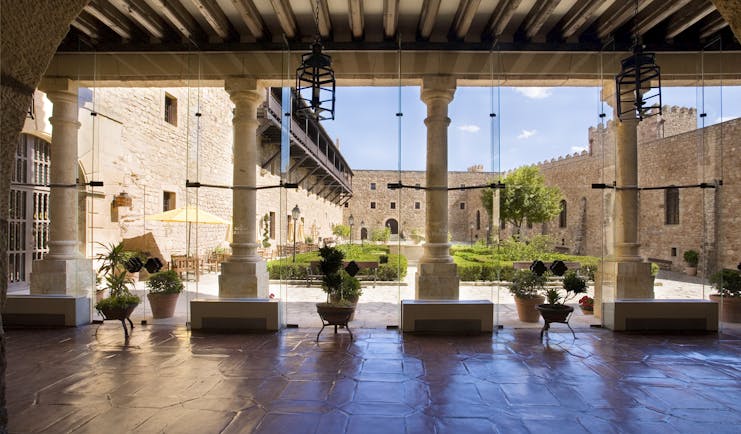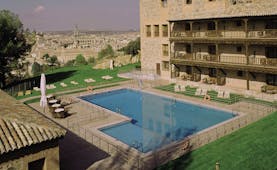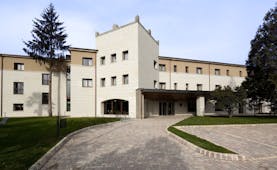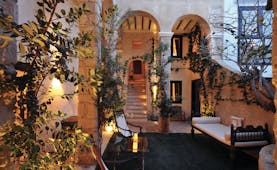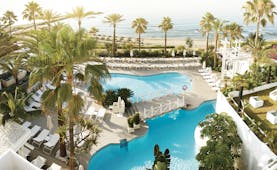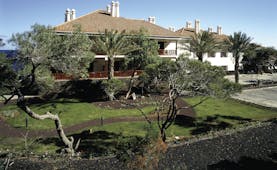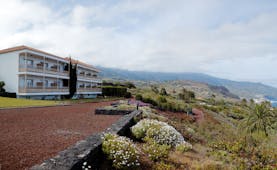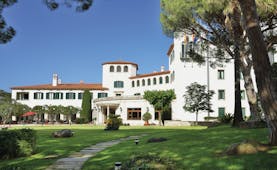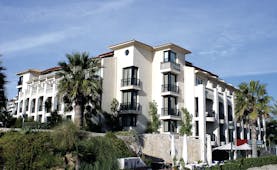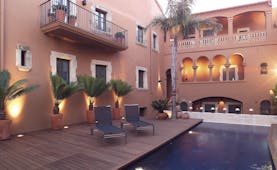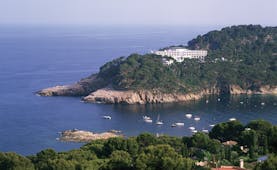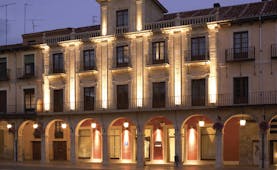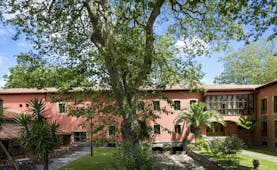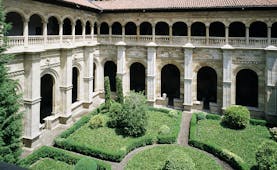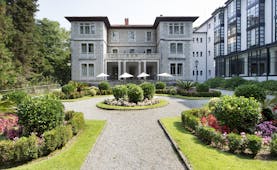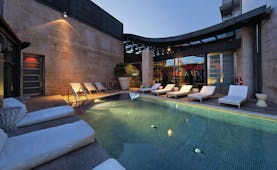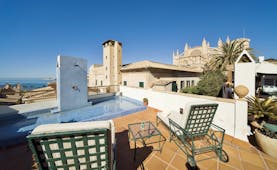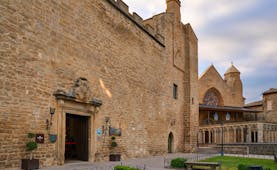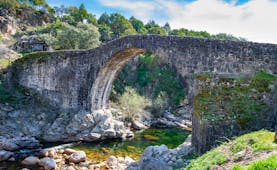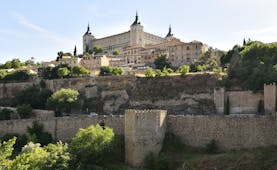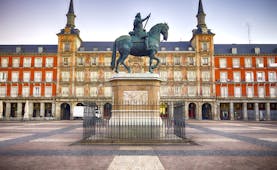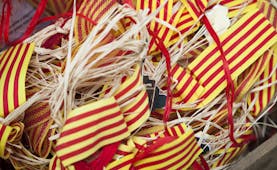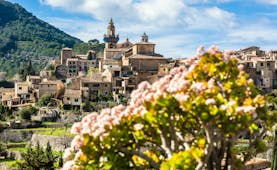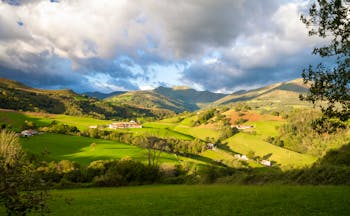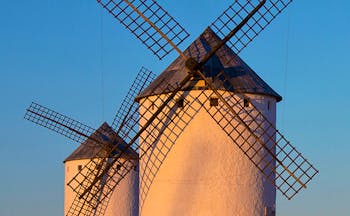Luxury bespoke hotel holidays to Parador de Siguenza, Guadalajara
Facts in brief
Official star rating 4
Location The hotel is located in the medieval hilltop castle, about 10 minutes’ walk from the cathedral.
Annual opening Open all year
Closest airport Madrid
Distance from airport 125 km
Closest railway station Siguenza
Distance from railway station 1 km
Hotel facilities and services
Restaurant, bar, garden, terrace, shop.
Out and about nearby
Siguenza and its cathedral with the famous Sepulcro del Doncel (tomb of a young page, commissioned by Queen Isabella), chapels and cemetery. In the town you will also find historic neighbourhoods, the medieval street of Travesaña and the baroque neighbourhood of San Roque. The church museum has works by El Greco and Zurbaran and a particularly beautiful ceiling in the sacristy. Nearby you will find typical small Castilian villages, Rio Dulce Nature Reserve and Pine Wood of Siguenza. The natural surroundings offer excellent habitat for griffon vulture, peregrine falcon and eagle owl.
Sports nearby
Hiking, birdwatching, cycling, horse riding
We had a wonderful holiday which exceeded our expectations. Great hotels with a good itinerary. We wouldn't hesitate to use your services again.Mrs J, June 2025
Holiday price guide Sample prices are per person based on two people sharing a Standard double room for 3 nights for a fly-drive holiday
From about
£580
Holiday Code EXH2023
The prices displayed here are a guide only. Each holiday price will be tailor-made at the time of booking to reflect all actual costs including up-to-date special offers.
Call us on 01392 441245
Luxury bespoke hotel holidays to Parador de Siguenza, Guadalajara
The Parador de Siguenza is a unique hotel experience which gives guests the opportunity to stay in a stunning hilltop castle. The Castle of the Bishops of Siguenza is an imposing medieval castle with foundations dating back to the 5th century. Throughout the years it has been held and added to by the Visigoths, Moors and Christians. The fortress was converted to an episcopal palace in the late 18th century, adding additional windows and balconies, however it was abandoned in the 1830s after being damaged by war and fire. The building was rescued and converted to a luxury Parador hotel in 1978 and offers comfortable accommodation in a slice of Spanish history. Many of the buildings original features and ambience have been retained, with the huge lounge being particularly remarkable. Converted from the castle’s original dining hall, this room has high ceilings with chandeliers, huge banners adorning the walls and suits of armour. Guestrooms are spacious and welcoming, and many of them have canopy beds and balconies. The restaurant boasts a stately and elegant dining room with magnificent views of the surrounding farmland and Pinar de Siguenza, the nearby pine wood. Dishes are made using the finest local and seasonal ingredients with specialities including oven-roasted lamb, cod, manchego cheese and borrachitos seguntinos for dessert (delicious sponge cake soaked in liqueur syrup). Visitors in October and November should be sure to try dishes featuring the delicious mushrooms from the region. The Parador also hosts themed dinners which accompany events such as opera and zarzuela (Spanish opera) shows. We recommend including the Parador de Siguenza as part of a Spanish touring holiday. Its location makes it ideal as a stopover between Central Spain and the Basque Country whilst train services to Madrid and Barcelona allow easy inclusion within a rail tour.
Room descriptions
Parador de Siguenza has 81 rooms, each with air-conditioning, heating, private bathroom, complimentary Wi-Fi, safe and mini-bar, television, telephone and hairdryer.
We had a wonderful holiday which exceeded our expectations. Great hotels with a good itinerary. We wouldn't hesitate to use your services again.Mrs J, June 2025
Holiday price guide Sample prices are per person based on two people sharing a Standard double room for 3 nights for a fly-drive holiday
From about
£580
Holiday Code EXH2023
The prices displayed here are a guide only. Each holiday price will be tailor-made at the time of booking to reflect all actual costs including up-to-date special offers.
Call us on 01392 441245
Luxury bespoke hotel holidays to Parador de Siguenza, Guadalajara
The journey and how you get there
For a holiday to the Parador de Siguenza, our clients usually hire a car from Madrid airport and include the hotel as part of a fly-drive touring holiday. We include flights from London and a hire car or rail travel, depending on what you would like to do and what is most appropriate to your overall journey.
Additional information
Children: An extra bed for a single child can be added in all room types.
We had a wonderful holiday which exceeded our expectations. Great hotels with a good itinerary. We wouldn't hesitate to use your services again.Mrs J, June 2025
Holiday price guide Sample prices are per person based on two people sharing a Standard double room for 3 nights for a fly-drive holiday
From about
£580
Holiday Code EXH2023
The prices displayed here are a guide only. Each holiday price will be tailor-made at the time of booking to reflect all actual costs including up-to-date special offers.
Call us on 01392 441245
Luxury bespoke hotel holidays to Parador de Siguenza, Guadalajara
About Heart of Spain
An Expressions tailor-made holiday to the Heart of Spain feature some of the best four and five star hotels in central Spain, featuring vineyard hotels, rural estates and city properties. Located at the geographical heart of Spain is its vibrant capital, Madrid, where days can be filled with art galleries and atmospheric outdoor cafes, and evenings promise an energetic nightlife. Surrounding the city are the dry plains of the country's central plateau which are divided by spectacular mountain ranges and dotted with numerous castles, magnificent cathedrals and ancient Roman ruins. The regions which make up Spain's central plateau have all played a hugely important role in the history of modern Spain, which is evident in the numerous castles which were built to protect towns and villages as the Moors fought the Christians in the 10th and 11th centuries. These are some of the least visited parts of Spain where few tourists venture outside of the main cities, ensuring that visitors will leave feeling like they have discovered something new. At the centre of Spain is Madrid, where atmospheric cobbled streets link bustling squares which are filled with pavement cafes and flea markets, whilst tree-line boulevards are overlooked by neo-classical buildings. Surrounding the city are the dry plains of the country's central plateau which are divided by spectacular mountain ranges and dotted with numerous castles, magnificent cathedrals and ancient Roman ruins. To the north of Madrid is Castilla y León, an elevated region which has played a hugely important role in the history of modern Spain. Rolling countryside is littered with historic cities, isolated villages and mediaeval castles, built by the Christians to defend against the Moorish invaders. Salamanca, Avila, Segovia, León, Valladolid and Burgos are all home to a wealth of art and stunning architecture, including Gothic cathedrals and Roman structures. Away from the cities are natural attractions including mountain ranges and nature reserves, with wheat fields and vineyards covering the high plateaus. To the south and east of Madrid is Castilla-La Mancha, an expansive region with dry plains stretching towards mountains in the distance. The predominantly flat scenery is made up of olive groves, wheat fields, extensive vineyards, hilltop castles and the iconic windmills described by Cervantes. Head to the historic city of Toledo, where Christian, Jewish and Arab cultures blend to create a popular tourist destination, or to Cuenca, a dramatic town where houses seemingly dangle over a plunging gorge. Further west towards the border with Portugal is Extremadura, a region with green pastures and rolling hills, forests and fertile river valleys, as well as charming towns boasting stunning examples of Roman architecture. Elaborate palaces and manor houses are found in clusters throughout the region, built by conquistadors with gold from the New World.
Highlights of the Heart of Spain
The three world-class art galleries which make up Madrid's Golden Triangle of Art, home to works by Pablo Picasso, Salvador Dalí and Francisco de Goya. The historical sights of Old Madrid, including the lavish Royal Palace, the grand Plaza Mayor and the city's spiritual centre, Puerta del Sol. Parque del Retiro, a popular spot for relaxation in the centre of Madrid with a boating lake. El Escorial, a large royal residence just outside Madrid which also functions as a monastery and is where many Spanish monarchs are buried. The Gothic cathedrals of León, Burgos and Toledo which feature stunning stained glass, mediaeval art and elaborate sculptures. The numerous castles which are scattered across the region including the Gothic-style Belmonte Castle, the Mudejár Coca Castle and the Moorish Alcazaba of Badajoz. The university city of Alcalá de Henares, birthplace of Cervantes, the 16th century author who wrote about the adventures of Don Quixote. The walled city of Ávila. The university city of Salamanca. Segovia, with its Roman Aqueduct and distinctive castle. Cuenca, a picturesque old town with houses which appear to hang over a gorge. The iconic windmills which sit on the plains near Consuegra. Roman ruins in Mérida. Elaborate palaces and manor houses in Trujillo and Cáceres. The wine-producing regions throughout central Spain including Ribera del Duero, La Mancha and Valdepeñas where visitors can visit vineyards and enjoy wine tastings. Mountain ranges which divide the central plateau, with many opportunities for walking and rock climbing.
Festivals in the Heart of Spain
February: Caja Madrid Flamenco Festival, February to March: Madrid Carnival, February to March: Madrid Contemporary Art Fair, March/April: Holy week celebrations, May: San Isidro bullfighting festival (Madrid), May/June: Toledo Corpus Christi processions (Toledo), July to August: Madrid summer arts festival, October: Saffron Rose Festival (Consuegra), October: Cervantes Week (Alcala de Henares), October to November: Madrid Autumn Festival
Gastronomy in the Heart of Spain
As expected, Madrid is home to some excellent restaurants serving a great range of cuisine from throughout Spain and around the world. Roasted meat and game as well as a variety of broths and stews are common features on menus throughout central Spain, where traditional cooking is simple and hearty. Cuisine varies slightly between the regions, with more paprika and saffron being used in the south. Various pulses are grown on the plains of Castilla y León, whilst Manchego cheese produced in La Mancha and high quality Ibérico ham is produced in Extremadura. There are a number of wine regions which produce high-quality red and white wines. Local dishes include ‘Pollo a lo Padre Pero’ (chicken with a spicy sauce), ‘El frite’ (fried lamb), ‘Sopa de ajo’ (garlic soup), ‘Pisto manchego’ (similar to ratatouille), ‘Yemas’ (a rich dessert made with egg yolks).
Climate in the Heart of Spain
The climate of central Spain is generally quite extreme, with extremely hot summers and bitterly cold yet dry winters. Rainfall is generally quite low thanks to the mountains which surround the region. Madrid can be almost unbearable in the summer months as temperatures reach 40 degrees, whilst during the temperatures regularly drop below freezing. Spring and autumn are the best times to visit as temperatures are warm and pleasant, although there is increased rainfall.







